The Coal Tit, scientifically known as a Periparus Ater, is the smallest among all the tits, with the sole distinguishable mark being a white patch situated on the nape of the bird. The upper portion of the coal tit is an olive-greyish colour while the underbelly is a buff colour. The birds crown as well as its bib are shaded black, and its nape and cheeks are of course, white in colour. The wings of the coal tit are also different from other tits, having two white winged bars on each of them. The bird’s legs are a bluish grey in colour.
The young ones of the coal tit are slightly different from the adults, being more of a brownish colour towards the upper portion, while their lower bodies, underbelly, nape and cheeks are a pale yellowish colour. The wings as well are coloured yellow. An adult bird grows to a full length of about 11.5 cm and weights around 8 to 10 grams. The wings of the coal tit are measure approximately 17 to 21 cm in length. The birds are found all through the year across the country.
The coal tit has a very high pitched voice, and its song as well comes out high pitched, with a ‘pee-chew’ sound repeated over and over, and at the same time is very fast. The coal tits call is similar to all of the other tits. The birds are normally seen as being residents wherever they find their habitat, rarely moving to different regions in different seasons, due to them being sedentary. However, it has been seen that coal tits may flock in woodland area during winter season with other flocks of tits.
The coal tits feeding habits are a natural diet of insects and seeds, mainly conifer seeds and beech mast. A garden bird tends to feed on sunflower hearts and black seeds, and sometimes the suet as well. These birds have an unusual chipmunk like attitude wherein they hide away food when there is extra, to save for when there may be scarcity. However, their memories do not serve them very well, and more often than not they forget where they’ve hidden the food and you would be surprised to find sunflower or such plants growing in the most unusual of places. And some other times, different species of tits may watch the coal tit hiding away its food and then eat it up once they leave.
The nests of coal tits are found in the hollows of trees or sometimes even in mouse holes, and is made using wool, dead vegetation, and moss and held together with spiders’ web. The female does the incubation of the egg, which lasts about 14 to 16 days. The bird gives around 7 to 15 eggs, which are glossy, smooth and white in colour. The young bird is fed dutifully by both the male and female birds. The coal tits are not able to survive in cold winters and harsh weather, but in recent years their mortality rate has come down due to warmer climates.










